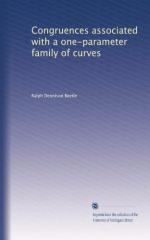|
This section contains 377 words (approx. 2 pages at 300 words per page) |
A Jordan curve is a curve that falls in a plane and is topologically equivalent to the unit circle in that it is simple, closed, and does not cross itself. A Jordan curve is a homeomorphic image of the unit circle such that the unit circle can be deformed into a Jordan curve by a continuous, invertible mapping. The curve divides the plane into exactly two parts, one part that is inside of the curve and another part that is outside of it. It is impossible to pass continuously from one part to the other without crossing the curve. A figure-8 curve is not a Jordan curve.
There are some interesting features of Jordan curves. For sufficiently smooth Jordan curves it is known that all four vertices of some square are contained inside of the curve. Also, for every triangle T and Jordan curve C, C has an inscribed triangle similar to T. These are important properties of simple, closed curves.
The term Jordan curve arose in the book Cours d'analyse de l'École Polytechnique, 3 vol. written by Camille Jordan, a French mathematician, in 1882. In this book Jordan examined the theory of functions from a modern viewpoint, dealing with the bounded variation function. He applied this function to the curve known as Jordan's curve. The Jordan curve theorem states that any simple closed curve divides the points of the plane not on the curve into two distinct domains, with no points in common, of which the curve is the common boundary. Jordan's proof for this theorem was very complicated and, as it turns out, invalid. It has been a difficult theorem to prove because of the generality of the concept of a simple closed curve. A simple closed curve is not restricted to the class of polygons or smooth curves but also includes all curves that are topological images of a circle. The first correct proof of this theorem appeared in 1905 in an article written by Oswald Veblen. Homology theory has been used to simplify the proof. One of the earliest uses of the term Jordan curve was in W. F. Osgood's article "On the Existence of the Green's Function for the Most General Simply Connected Plane Region" that appeared in July 1900.
|
This section contains 377 words (approx. 2 pages at 300 words per page) |


